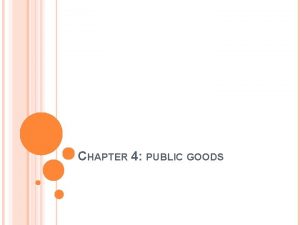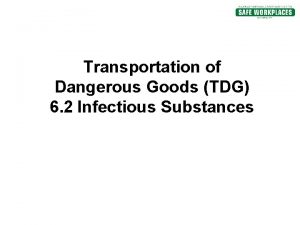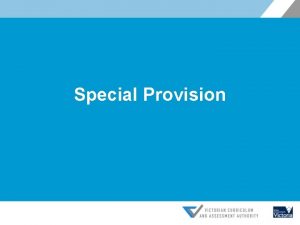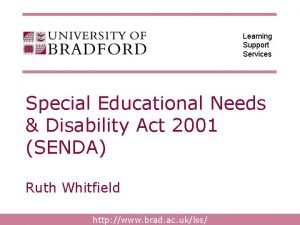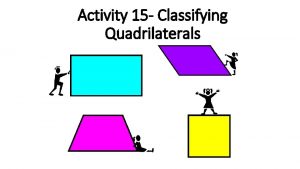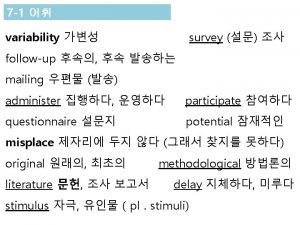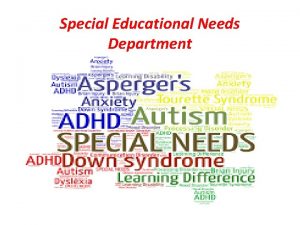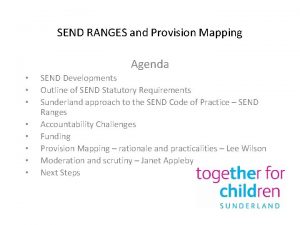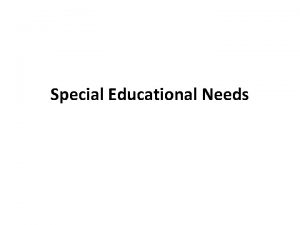SEND PROVISION Special educational provision is additional to






- Slides: 6

SEND PROVISION Special educational provision is ‘additional to or different from’ that normally available to pupils of the same age, which is designed to help children and young people with SEN or disabilities to access the National Curriculum at school. • Reasonable adjustments and responsibilities - Code of Practice - Chapter 6. Paragraph 43 refers to equality. You can’t be outstanding if you’re not inclusive! • High quality teaching – ‘Every teacher is a teacher of SEND’ • Co-production – including pupils, parents, School, LA, Trust etc. • Interventions – SMART targets, differentiation and support based on specific needs • Putting the child first – what they need is what they get! SEND and PP overlap and are triple funded • Whole school review of SEND https: //www. sendgateway. org. uk/wholeschool-send/what-works/

IMPORTANCE OF DIAGNOSTICS • The right interventions cannot be put in place if the child’s needs have not been fully identified. It is important to take the time and engage the appropriate professionals to do this – SENCO, EP, CEAT, Sa. LT etc. • Due to lack of resources and funding, we tend to use interventions that we have available, rather than drilling down into the precise needs of the child and then personalising support around them • Cognition and Learning - Reading and Spelling standardised tests – NARA, SSRT, SWRT, YARC, SWSP, Parallel Spelling and NVR tests • Sp. LD – Dyslexia and Dyscalculia Screeners, Dyslexia Portfolio, Ph. AB • Communication and Interaction – BPVS, ADHD, ASC checklists • SEMH - Boxall, SDQs • Physical and sensory – Checklists and Sensory 101 • Also consider qualitative evidence over time - improved absence and exclusion rates, behaviour, social interaction/communication skills, mental health etc.

STAFF AND TRAINING • Supporting children with additional needs should be a whole school effort. • According to the code of practice, every teacher is a teacher of SEND and it should be a priority in our school. • The reduction in SEN services, available via the local authority, means that it can be more difficult for schools to access appropriate services and funding. Building a team of skilled practitioners and where necessary pooling resources with other local schools, can be beneficial. • Support, advice and training can be accessed via EP, CEAT, Sa. LT, OT and sensory processing • Online agencies include NASEN, BDA, ADHD Foundation, Communication Trust, National Autistic Society, BDA, Visyon-Mental Health training, Virtual Schools etc.

HIGH QUALITY TEACHING • High quality teaching is the foundation for progress for all children. It is believed that the difference between poor teaching and highly effective teaching is just under half a year’s extra progress for most students (Machin, Murphy and Hanushek, 2011). • When the expected progress isn’t made, the first port of call should be to review the Quality First Teaching Strategies before assuming a child has SEN. • Provide a relevant and flexible curriculum and invest in teacher development. A curriculum that addresses the needs of all learners, particularly around points of transition, can have a significant impact on attendance, punctuality, emotional well-being and behaviour, as well as on academic achievement.

INTERVENTIONS • It isn’t the volume or variety of resources that makes the difference to outcomes for children but the way they are targeted and implemented. • Cognition and Learning: Engaging Eyes, Fluency Builder, Precision Teaching of reading/spelling the common words, tables, number facts etc. Nessy, IDL, Beat Dyslexia, Launch the Lifeboat, Wellington Square, Toe by Toe, Plus 1 and Power of 2, Numicon, My Maths etc. • Communication and Interaction - SALT strategies/programmes - Black Sheep resources, Mr. Goodguess, Socially Speaking, Talkabout Activities, Social Stories, Lego Therapy etc. • Social, Emotional and Mental Health – counsellor, ELSA, Visyon resources, 3 or 5 point scale, books re managing emotions, differences, bereavement etc. Friendship Terrace, friendship/social skills programmes, Restorative Justice, Homunculi, 101 sensory games • Sensory/Physical: Dough Disco, Motor Skills United, Right From the Start, Speed Up, Nessy Fingers, sensory toys • Specialist equipment - Visual Stress overlays, wedge cushions, writing slopes etc. • EEF: https: //educationendowmentfoundation. org. uk/ • What Works: https: //www. sendgateway. org. uk/whole-school-send/what-works/

PARENTS The Lamb Inquiry of 2009 highlighted the importance of schools communicating openly, frequently and honestly with parents and children with SEN. Parents play a large part in ensuring good provision for their children. They know their children best and will probably be able to give you great insight into how best to support them. If you can give time to parents, it is beneficial for you, them and most importantly, the child. Pupils must be given the opportunity to have a voice and invest in their own development. Parents have to trust schools to put in the appropriate provision for their child. This starts with regular communication and transparency regarding provision. • Encourage parents to come into school and discuss their concerns as soon as possible so that situations don’t start to escalate. • Listen to and value what parents say – they know their child! • Communicate what you are doing so they know their child is having their needs met. • Regular review meetings and emails offer good ways to communicate.
